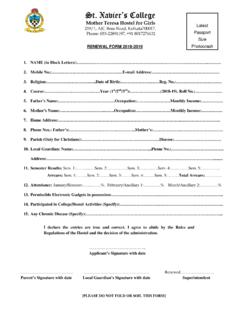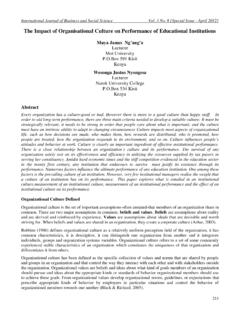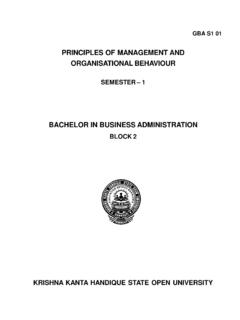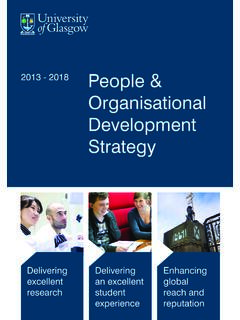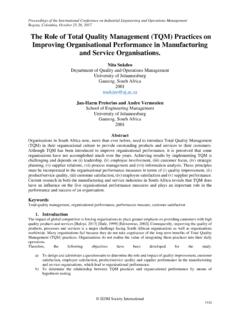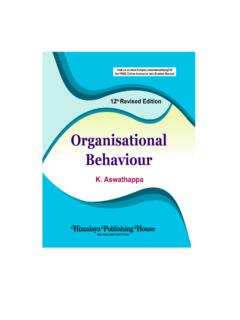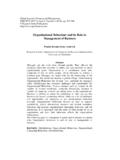Transcription of Management Concepts & Organisational Behaviour Unit – I ...
1 MBA-I Semester Paper Code: MBAC 1001. Management Concepts & Organisational Behaviour Unit I. Nature of Management - Social Responsibili Ties of Business - Manager and Environment Levels in Management - Managerial Skills - Planning - Steps in Planning Process - Scope and Limitations - Short Range and Long Range Planning - Flexibility in Planning Characteristics of a sound Plan - Management by Objectives (MBO) - Policies and Strategies - Scope and Formulation - Decision Making - Techniques and Processes. Unit-II. Organising - Organisation Structure and Design - Authority and Responsibility Relationships - Delegation of Authority and Decentralisation - Interdepartmental Coordination - Emerging Trends in Corporate Structure, Strategy and culture - Impact of Technology on Organisational design - Mechanistic vs Adoptive Structures - Formal and Informal Organisation.
2 Unit III. Perception and Learning - Personality and Individual Differences - Motivation and Job Performance - Values, Attitudes and Beliefs - Stress Management - Communication Types-Process - Barriers - Making Communication Effective. Unit IV. Group Dynamics - Leadership - Styles - Approaches - Power and Politics - Organisational Structure - Organisational Climate and culture - Organisational Change and Development. Unit V. Comparative Management Styles and approaches - Japanese Management Practices Organisational Creativity and Innovation - Management of Innovation - Entrepreneurial Management - Benchmarking - Best Management Practices across the world - Select cases of Domestic &. International Corporations - Management of Diversity.
3 1. 2. UNIT - I. Lesson - 1 : Nature Of Management Objectives After reading this lesson, you should be able to: Understand The Nature Of Management ;. Identify And Describe The Functions Of Management ;. Understand The Social Responsibilities Of Business; And Appreciate The Interests Of Various Stakeholders In The Business. Lesson Outline Management As Science Management As Art Management As Profession Professionalisation Of Management In India Functions Of Management Review Questions 3. Introduction: Take a close look at the society around you. You would find the existence of several organizations. To mention a few, the business organizations that produce goods or services, hospitals, religious and social institutions like charities, schools, colleges and universities.
4 All these organizations exist to achieve pre-determined objectives. They affect our lives in many ways. Though there are vast differences in their functioning and approaches, they all strive to achieve certain objectives. It must also be noted that organizations cannot achieve the objectives effortlessly. They are achieved through systematic effort. Several activities have to be performed in a cohesive way. In the absence of systematic and cohesive performance of the activities to achieve the objectives, it is no wonder that the resources of organizations would be underutilized. As such it is the function of the Management to facilitate the performance of activities such that the accomplishment of the objectives becomes possible.
5 Meaning of Management Management is understood in different ways by different people. Economists regard it as a factor of production. Sociologists see it as a class or group of persons while practitioners of Management treat it as a process. For our understanding, Management may be viewed as what a manager does in a formal organization to achieve the objectives. In the words of Mary Parker Follet Management is the art of getting things done through people . This definition throws light on the fact that managers achieve organizational goals by enabling others to perform rather than performing the tasks themselves. Management encompasses a wide variety of activities that no one single definition can capture all the facets of Management .
6 That is why, it is often said that there are as many definitions of Management as there are authors in the field. However, the definition given by James Stoner covers all the important facets of Management . According to him: Management is the process of planning, organizing, leading and controlling the efforts of organization members and of using all other organizational resources to achieve stated organizational goals . 4. The definition suggests: Management is a continuous process;. Several interrelated activities have to be performed by managers irrespective of their levels to achieve the desired goals;. Managers use the resources of the organization, both physical as well as human, to achieve the goals;. Management aims at achieving the organisation's goals by ensuring effective use of resources in the best interests of the society.
7 It is evident that the emphasis is on achieving the objectives by using material, machinery, money and the services of men. These inputs are drawn from the environment in which the organization exists. Whether an organization is engaged in business or non-business, the various inputs are judiciously used to produce the outputs. The process involving the conversion of inputs into outputs is common to all organizations and is shown in figure INPUTS TRANSFORMATION OUTPUTS. PROCESS. EXTERNAL. ENVIRONMENT. Figure : INPUT OUTPUT MODEL. Depending on the nature of business or activity that a firm is engaged in, the output of the firm may be a physical product or service. Since a business organization is an economic entity, the justification for its existence lies in producing goods and services that satisfy the needs of the people.
8 As could be seen in the figure, the organization draws several inputs from the environment, converts them into products or services and sends them back to the environment. Environment here means the larger system, , the society in which the firm exists. Therefore, it goes without saying that how effectively the goods and services are produced is a matter of concern for any society, given the scarcity of resources. Effective Management therefore plays a crucial role in this context. 5. Nature of Management The practice of Management is as old as human civilization. In fact, much of the progress of mankind over the centuries may be attributed to the effective Management of resources. The irrigation systems, the public utilities, the construction of various monuments like Taj Mahal, and the Egyptian Pyramids of the bygone era amply demonstrate the practice of Management in the olden days.
9 Similarly, the ancient civilizations of Mesopotamia, Greece, Rome and Indus-valley displayed the finest practices of Management of those periods. However, the study of Management in a systematic way as a distinct body of knowledge is only of recent origin. That is why, Management is often described as oldest of the arts and youngest of the sciences . Thus, the practice of Management is not new. It has been practiced for thousands of years. But the science part of it the systematic body of knowledge' is, no doubt, a phenomenon of the present century. The traditional Management practices remained quite stable through the centuries until the birth of industrial revolution in the mid 18th century. The industrial revolution brought about the substitution of machine power for man power through several scientific inventions.
10 As a result, within a few decades, the landscape of industrial activity had undergone a metamorphic change. Man's quest for new ways of doing things, coupled with his ingenuity in adopting the scientific and technological inventions in the production of goods and services resulted in: Mass production in anticipation of demand;. Advent of corporate form of organization which facilitated large scale production;. Spectacular improvements in the transport and communication facilities;. Increased competition for markets;. The establishment of new employer employee relationship; and A radical change in the aspirations and expectations of the various stakeholders of business. Industrial revolution had thus sown the seeds of modern Management .

